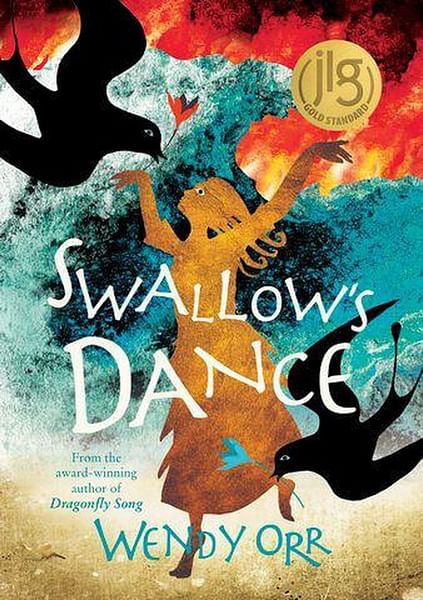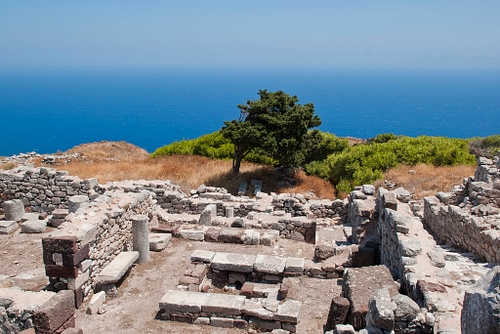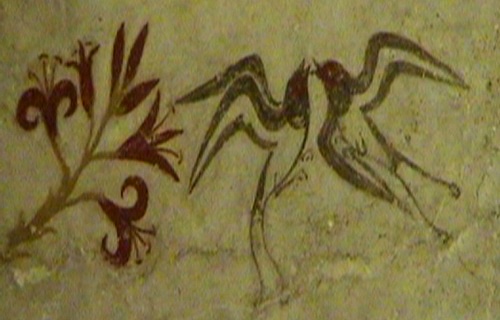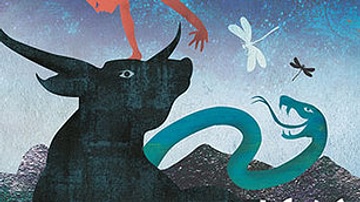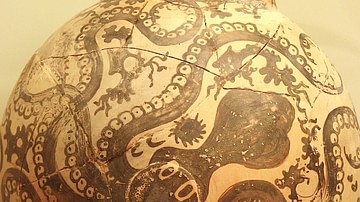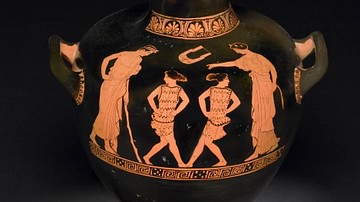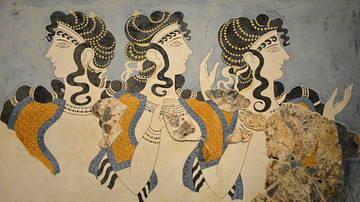In this interview, Ancient History Encyclopedia is speaking with Wendy Orr, the rather prolific author of numerous books who has recently published the book Swallow's Dance. It is a book of historical fiction set in the Bronze Age Aegean that we think is going to be of great interest to our readers here at Ancient History Encyclopedia.
Jan van der Crabben (AHE): Could you tell me a little bit about Swallow's Dance, what is it about, and just generally introduce it?
Wendy Orr (Author): Swallow's Dance takes place in the Aegean Bronze Age, and it starts really with the eruption on what is now Santorini, which is probably the greatest volcanic eruption in history. I never exactly know how my books are formed, and my original plan was that Leira, who was the protagonist, was going to end up as a Minoan seal maker. These seals fascinate me; you really need to stare at it to see what is on it. So, I started playing with this idea, and I think that I had actually started planning that she would become a refugee because there was nothing left of the island of Santorini. Well, the island is still there, but it was totally uninhabitable after.
So, I started playing with that, and as I was writing it, the refugee crisis in Greece just really became enormous. Friends of mine actually went there with UNICEF while I was writing. And so, of course, that did bring it home. So I started playing with this girl, and I think the single thing that really made my girl start off as an upper-class priestess was a report that was going around on Facebook about this: "These people weren't really refugees because they had mobile phones."
Jan: Oh, yeah. I have read many things like that. Yes.
Wendy: So obviously, if you have a mobile phone, it is irrelevant that you lost your home and your country and your family, you know, but you have got a mobile phone. Who could afford a mobile phone? So I started really looking at that. I created this girl who starts off as a sort of upper-class girl, and the premise I have taken is that Minoan society was a caste society. So, I put her into the priestly class, but then with the eruption, she gets off the island in time because in Thera there was a massive earthquake first.
Jan: Right. There is the first earthquake, and then the village kind of half-collapsed, and they are already refugees on their own island before the eruption happens, right?
Wendy: Yes. And that is it, I mean, you can become a refugee in your own country. So, I started thinking about this, and then I thought about where she would go. I took her to Crete, which was their trading partner, but I wanted her to have a profession, which was obviously not going to be a priestess when you move into a foreign country, even if you started off as a sort of visitor rather than a refugee.
My original plan was she was going to be a seal maker because these little seals, which are made of precious metals or clay, a wide variety of things, different rocks, obviously depended on how much money you had. I was lucky enough to actually get a grant from the Australia Council to go to Santorini and Crete to research it. My plan was I was going to spend the time at the museum, and I would see a seal, and that seal would speak to me, and that is how I would create her. And I certainly spent wonderful hours at the museum in Heraklion, but I never found one that spoke to me.
What I did find was this wonderful archaeologist who I have been writing to for some time, Dr. Sabina Beckman. She invited me to spend time with her, and I spent one of the best days of my life with her. We went to Gournia, which she had helped to excavate, and walked around, and at one point she said: "This is the potter's floor." The sand there was soft, it was all gravel everywhere we walked, and on this 4,000-year-old floor, there was still clay. It was powdery. That was magical. She sort of plotted out where I should go, like: "OK, you have to go to the shrine on Mount Juktas". So a few days later, we climbed this mountain, and there was all this pottery, just everywhere outside the perimeter fence, which was very exciting.

About halfway down the hill, we found a pottery shard! It was legitimate to take it since it was totally out of context in the middle of a hill. It was glazed and fired; Sabina said that it was probably a ceremonial vessel, but I cannot quite remember why she knew that. There was a little line down it, and hoping it to be Linear A or something, I showed it to her. She said that is actually just sort of 4,000 years of being scratched down the mountain. But on the other part, there is a thumbprint. I mean, a thumbprint just gives you chills, does it not?
Jan: It does. It is not something that you would expect to find from somebody who lived 4,000 years ago, right?
Wendy: No, but if you made that little mistake and you have glazed your thumbprint in and it is still there, then it does not go away. And I said: "Oh, where?" I put my hand on it, and I could feel where that thumbprint was. My thumb would be probably bigger than a Minoan potters', but it seemed to just fit there. Well, obviously, my Leira had to become a potter then.
Jan: Basically, in order to do the research, you went to Crete and you got a personal tour with an archaeologist of the sites. That must have been an amazing experience and it really opened your eyes to that world, right?
Wendy: Oh, it just is so totally different from reading. I spent 30 years on and off reading this background. And, of course, that has become so much easier when we were walking around Gournia when the site was totally deserted, and then all of a sudden, there was this overwhelming scent of thyme. And so, I have read about that. But it is different to smell it. About 100 meters away, there was a woman walking a dog, and the scent had alerted us before we saw her. That is that sort of little powerful thing that you cannot quite imagine how it is.
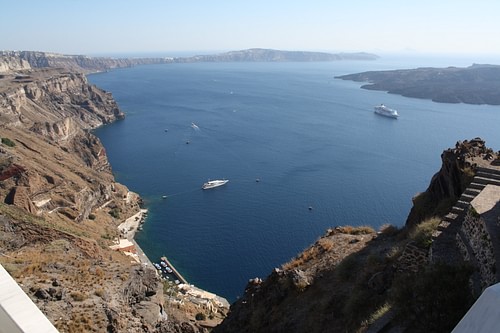
So, what was also interesting, though, was when I went to Akrotiri on Santorini, I was not able to speak to an archaeologist there. But when I went there, I was reading the common theory that because no skeletons had ever been found in the ruins of Akrotiri, everybody escaped. That is just not possible. While I was still planning the book, there was an earthquake in Italy, and I remember looking at these scenes of, again, people, refugees in their own country camped in the hills. People do not get on boats and leave the country. They go to the hills.
Jan: Especially with an earthquake, you are safe if you are not in a house. I would also imagine that if there is an earthquake and the houses collapse, just as nowadays, back then people would have also dug up the bodies and given them a proper burial. So, it would make sense if you do not necessarily find skeletons inside the ruins because if there were survivors, they would have probably been removed.
Wendy: Yes, exactly. And as far as getting off in front of this volcano, Akrotiri probably had about 10,000 inhabitants. That is a lot of people to get off in small sailing ships with about 30 rowers. These are not things that transport 10,000 people.
I was on the island of Santorini and talked to a tour guide who told me about the theory that nobody who was on that island survived because the poisonous gas would kill ships out to sea. It took me three months to go back to the book, and I could not say: "Oh, we will just change a few things here."
The people become very real to you while you are writing, and just trying to assimilate this and the magnitude of her loss, obviously I had to get her off the island or there is no story. But to think of your whole land just disappearing! It was huge, so the on-the-ground research actually almost made it harder for a while there.
Jan: One thing I was wondering in the book: When it starts out, you describe quite vividly the two things that struck me that I thought were really interesting. You talk about the girls and the priestly class collecting these crocuses for a ceremony of the Swallow Clan. I was wondering, where did you get the idea of the crocus collection and that of a Swallow Clan from? To what extent did you use historical background that you found or read about or saw there, and to what extent did you take artistic liberty to tell a really interesting story?
Wendy: Well, that part, actually, I tried to make quite accurate. The crocus pickers or saffron gatherers is a really famous fresco. It seems that saffron definitely had to have some ritual component; these girls were not saffron pickers in a sort of mass-produced market. Some of the uses of saffron are for easing menstrual pain. You could look at that; does that mean it was part of initiation? That was how I played with that.
The swallow part I really believe is probably a very simplified approximation to the truth. It follows a wonderful legend that swallows used to nest in Santorini — and the frescoes are full of swallows. I think it might have even been quite a late draft, I changed them being the "priest folk" into being the "Swallow Clan". Because the swallows were so highly represented, they obviously had ritual significance or mythological significance. So it seemed a nice name for the clan. There is no contemporary evidence for any swallow's dance, but some frescoes definitely show dance. When the book went to print, I got a notification from academia.edu about a new paper that might interest me: It was about Minoan Epiphany dances using birds, bird epiphanies. I am sure that swallows are mentioned, I do not think I have made that part up, but it was one of those moments I thought I have made all this stuff up, and actually it is probably not far off.
Jan: That is really great.
Wendy: Really lovely when that happens!
Jan: Absolutely. You go into a lot of detail as well on essentially the social organization of Akrotiri. I was wondering to what extent is that based on research and to what extent did you have to fill in gaps?
Wendy: Well, there is a lot of gaps. With the Minoans, there is this kind of presumption, because it appears to be quite a female-centric society, that everything was nice. I do not actually think that is true. Also, we do not really know that women were the leaders. It seems likely to me that it was a matrilineal society. There is so much emphasis on women in all the frescoes and art. You would like to guess that it was a more equal society, but I do not think it was necessarily all flowers and dancing. Pretty much all the world had slaves. It would be very hard in those days to have the kind of really sophisticated luxurious society that the upper classes had without slavery.
Jan: I am probably not the ideal target audience for your book, but I really enjoyed it. I really got drawn in; it is very universal in terms of experience. Anybody could have this experience, whether they are upper class or not, whether they are rich priests, men, women, it does not matter what age, you would still run through this same experience of losing everything to disaster. What I also found was very interesting is the idea of ending up in a society that does not necessarily want you.
Wendy: No, because it is hard to be welcoming when the times are tough for you. In this case, Crete obviously had huge damage from the tsunami that followed the eruption. Also, before I realized that not so many people would have escaped, I was looking at how people may have reacted to a flood of refugees. In any time of hardship, whether it is a real hardship - like having your own towns wiped out by a tsunami - or just a more minor period of unemployment, people turn against refugees because they are "taking our jobs" or all those things. You could go somewhere as a visitor and be very welcomed, but if you turn up a few weeks later with no money and in desperate need, you might not be so welcome. As you said, the history is a very different world, but I do not think human nature has changed very much.
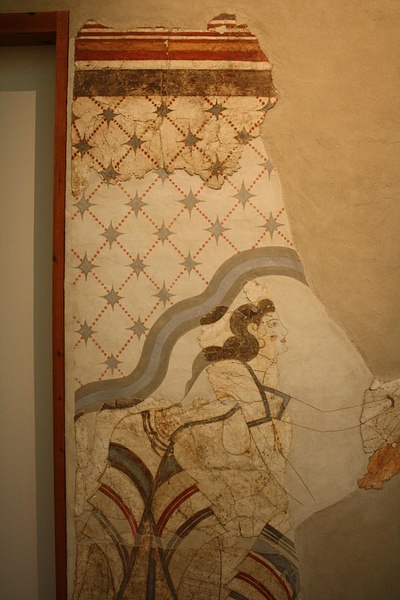
Jan: You also have another book in the works, do you not?
Wendy: Oh, yes. Thank you. Well, Cuckoo's Flight is the same world, it follows on, but it is not a direct sequel to Swallow's Dance. But it is a sequel in the sense that Leira is now a very, very old grandmother. I did not want her to be really part of the story and so I have made her an exceptionally old grandmother, especially for those days.
Cuckoo's Flight introduces more of the Mycenaean wars. It is still in the sort of later aftermath of all the things that happened from the Santorini eruption, which caused the world's climate to alter for that period and probably cost a lot of famine. It would take a while to rebuild all that the tsunamis washed away. Cuckoo's Flight will be released in March next year in North America, Australia, and New Zealand. And then the Australian book goes to the UK as well.
Jan: Right! So, Cuckoo's Flight... put it on your watch list! Well, thank you so much for having taken the time to talk with us today. It has really been a pleasure.
Wendy: Well thank you Jan, it was really nice to meet you after a little while of corresponding.
Jan: It has been a pleasure to read your Swallow's Dance. It is really highly recommended, and thank you very much!

